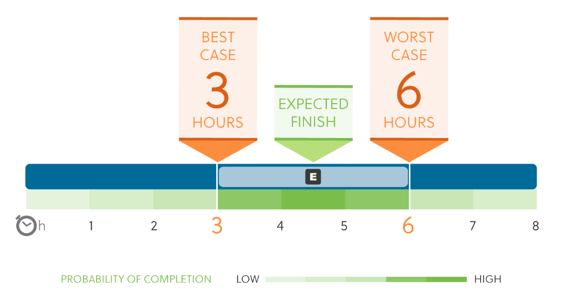Building a project schedule should be easy, right? Just lay out the tasks, assign them, figure out how long they’ll take, and boom – you should have a completion date calculated in no time. But would you bet your salary on it?
The truth is that “figuring out how long they will take” is usually, at best, a guess. And adding up a bunch of guesses gets you a pretty risky timeline. One most people are wary of, so they slap a big buffer on the end of the schedule and call it a day. Feeling confident yet? If not, have no fear. There’s an easy way to get a more accurate project schedule!
 In LiquidPlanner, you provide simple “best case” and “worst case” estimates of the effort it will take to complete a task. (i.e., “Write requirements document” will take 4 – 6 hours.) Those two numbers (representing your 80% confidence levels) work out to a little statement of probability. Put in a whole bunch of “ranged estimates” and pretty soon you have a whole statistical picture of when you’re likely to complete the set of tasks.
In LiquidPlanner, you provide simple “best case” and “worst case” estimates of the effort it will take to complete a task. (i.e., “Write requirements document” will take 4 – 6 hours.) Those two numbers (representing your 80% confidence levels) work out to a little statement of probability. Put in a whole bunch of “ranged estimates” and pretty soon you have a whole statistical picture of when you’re likely to complete the set of tasks.
LiquidPlanner’s scheduling engine uses three factors to calculate start and finish dates for your work. Notice that the best case/worst case estimate of remaining effort is one of these key inputs:
- Remaining effort estimate on tasks
- Priority order of tasks
- Availability of task owners
Don’t worry – you don’t need to have passed college statistics to get a statistically accurate project schedule. Just follow these simple steps and watch your schedule appear before your eyes.
- Add your task and assign it to the person who will do the work.
- Give the task a best case / worst case estimate of the number of hours of work the task requires.
- Prioritize the task along with the other work assigned to that person.
- Hover over the schedule bar to see when you’re likely to complete the task.
You’re probably thinking, “That’s all well and good, but what about my deadlines?” There’s a place for deadlines in LiquidPlanner, of course. You can enter deadline dates for each task or project independent of the schedule dates. That way, you can let the schedule tell you if the deadline is realistic. This works well in a living system, because today your schedule may be perfectly on track. If tomorrow something changes to put your date at risk, the system will let you know. If your deadline date is “in the red,” you can take a number of steps to fix your project schedule:
- Add additional resources or re-prioritize work.
- Make sure that the tasks driving the date out are estimated correctly (i.e., has everything been updated?)
- Cut the scope of work.
- Re-set expectations with the stakeholder that the date is not realistic.
For all knowledge-worker project teams, uncertainty is an inherent part of projects. By capturing the uncertainty associated with task effort, a team can have a more accurate sense of the overall project’s uncertainty than most traditional methods provide (i.e., project buffers). Furthermore, by exposing that uncertainty early on in the process, steps may be taken to mitigate risks before they impact the project schedule.
Related Articles
Estimating in Ranges
Priority-Based Scheduling
Deadline Dates and Risk Alerts
Setting Up the Workspace

